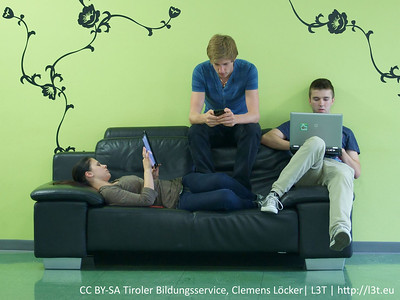
While online learning methods have existed for decades, the past couple of years have necessitated a greater shift from in-person classroom learning to incorporating online tools and learning management systems. We have seen how offering courses in a digital medium has provided flexibility and accessibility to students, but it has also introduced us to the strengths of asynchronous learning. As we continue to enhance online instruction in this new “normal,” it is essential to explore the next frontier of digital learning: mobile learning. Mobile devices, such as smartphones and tablets, offer unique opportunities to enhance online learning experiences. In this blog post, we will explore the benefits of mobile learning and discuss how you can incorporate it into your online courses.
So, what is Mobile Learning, and why should I incorporate it in my course?
Mobile learning refers to any learning that can be done on a portable device like smartphones or tablets. These portable devices have been treated as peripheral tools that students use if they do not have immediate access to a computer and are seldom considered as the primary mode that students use to do any coursework. However, instruction during the COVID pandemic and the pivot to online instruction brought attention to the issue of digital poverty, or a lack of access to computers and the internet in lower socioeconomic communities. Students experiencing digital poverty were more likely to attend in-person courses before the pandemic and were unable to attend synchronous sessions to the same degree throughout the pandemic due to lack of access to computers and the internet. According to Pew Research Center Mobile Fact sheet, low-income households use home broadband less than other income brackets but are the most reliant on mobile devices. So, while students from low-income households might have limited access to computers and the internet, they are more likely to have access to a portable device like a smartphone. This presents an opportunity to explore a new tool for online instruction.
Benefits of Mobile Learning
Here are a few key benefits of incorporating mobile learning as part of course design:
- Just in time learning: Mobile devices allow students to access course content anytime, anywhere. If they encounter any difficulties understanding a concept, they can review content immediately on their device.
- Alternative communication modes: Mobile devices allow students additional communication channels, enabling students to contact instructors in a method that is convenient to the student. Students can text their instructors to seek clarification or address issues promptly as an alternative to traditional email communications. Instructors should still set parameters such as digital office hours, when they can respond promptly or indicate an estimated turnaround time for a response. Allowing students to message as issues arise will decrease the number of issues that may fall through the cracks. In addition, students can build community among themselves by utilizing apps that allow texting and group chats in real time, like Slack or Discord.
- Self-paced learning: Mobile devices allow students to learn on the go and at their own pace. They can listen to lectures or access readings while performing daily tasks or during downtime, maximizing their time and fitting learning into their busy schedules.
- When broadband or Wi-Fi is unavailable: Students who want to do coursework while traveling can have the freedom to download and interact with course content when Wi-Fi is not available. This is especially useful for students who work in areas where Wi-Fi is limited.
- Digital literacy: Incorporating mobile device use in coursework will allow students to gain experience in a marketable skill, especially in careers that require working outside of a traditional office setting (i.e., geology, social work).
How can Mobile Learning be incorporated in online courses?
Here is a short list of suggested ways you can kickstart incorporating Mobile Learning into your online courses:
- Break up long lecture videos into bite-sized learning clips, preferably 3-5 minutes long. Focus these short clips on one topic or objective. This will not only allow students to pace out the content to fit busy schedules but will also allow students to be able to later refer to content when they need to review. Don’t forget to clearly label these clips so students can find them in a keyword search.
- Make videos, transcripts, and reading resources accessible and downloadable so students can access them on the go.
- Incorporate asynchronous discussions so students can take time to respond to peers and craft robust responses. For more on asynchronous discussions, please refer to last month’s post.
- Allow for multiple channels of participation by offering a balance of low-stake discussions and submission assignments. Give students a choice of formats to allow them to decide how to best complete an assignment. Mobile devices allow students to record video, audio, take pictures, or share social media they might find relevant to course content, and thus gives students the opportunity to submit more creative and robust coursework. Microsoft 365 also allows students to save content they have created on their mobile device(s) to the cloud that can then be shared out or worked on when a computer or the internet is not accessible.
- When scheduling synchronous Zoom meetings, include information on how to download the Zoom mobile app and how to join meetings from their mobile device(s).
Word of Caution
There are a lot of third-party tools in the market that advertise being mobile compatible. Unless the tool is one you are familiar with and how it behaves on mobile devices, it is best to avoid adding third-party tools just for novelty. If there is a tool you would like to try out in your course to increase engagement on mobile devices, use it for a low-stakes activity so you can see how it behaves and whether it is a good fit for your course goals. If you have questions about how third-party tools can be integrated in Sakai or would like to schedule a consultation, please reach out to ITRS (Instructional Technology & Research Support). For assistance designing mobile learning activities for your class, reach out to the Office of Online Learning at online@luc.edu to schedule a one-on-one consultation with one of our instructional designers.
Further Readings
Colin M., Eastman S., Merrill M., Rocky A. (2021) Leveraging Mobile Technology to Achieve Teaching Goals. Educause Review. Retrieved on July 10, 2023 at https://er.educause.edu/articles/2021/3/leveraging-mobile-technology-to-achieve-teaching-goals
Singh H. (2020). Why Mobile Learning Is Now More Than Just A Nice-To-Have. eLearning Industry. Retrieved on July 10, 2023 at https://elearningindustry.com/why-mobile-learning-is-more-than-just-nice-to-have






